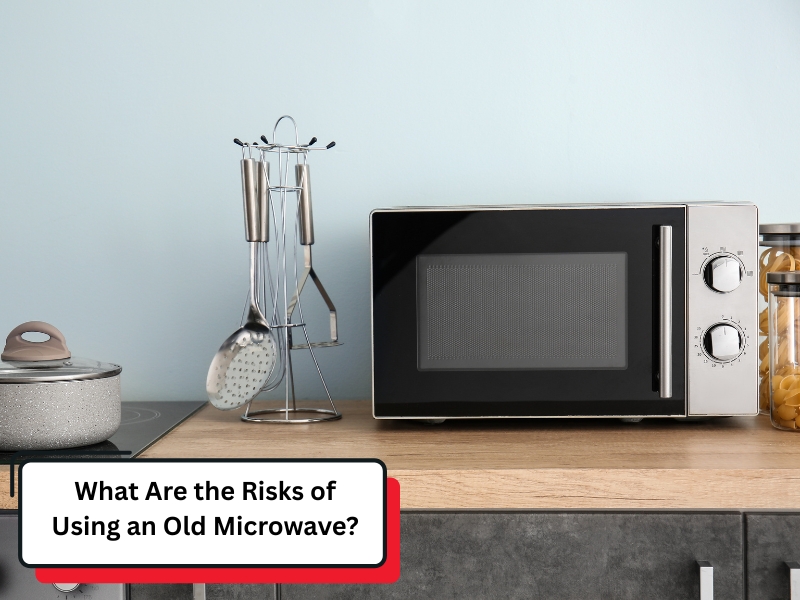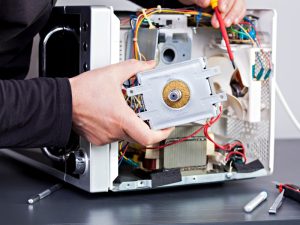Microwaves are a staple in most kitchens, offering convenience and quick meals. However, using an old microwave can present certain risks that are often overlooked. Over time, microwaves can wear down, leading to potential safety issues, decreased efficiency, and even health risks. Understanding the risks associated with aging microwaves is essential to make informed decisions about keeping or replacing them with a newer model. In this article, we’ll explore the potential dangers of using an old microwave, signs that it may need replacing, and tips for extending its lifespan.
Can an Old Microwave Be a Safety Hazard?
Microwaves may seem like a safe, everyday appliance, but they can pose safety risks when old or worn out. The components of a microwave degrade over time, potentially causing issues such as electrical malfunctions or fire hazards. Knowing the signs that your appliance might be becoming unsafe is essential.
- Malfunctioning door seals – Microwaves can leak radiation if the door doesn’t close tightly, leading to burns or exposure.
- Fraying power cords – Exposed wires can cause short circuits or even fires.
- Overheating – If it starts overheating more frequently, it could be due to internal damage.
- Rust on the interior – Rusty walls or exposed areas inside the appliance can interfere with cooking efficiency and even cause sparks.
- Broken or cracked parts – A microwave with cracked or damaged parts can malfunction, potentially creating a fire risk.
An old microwave can be a safety hazard due to faulty seals, electrical issues, or physical damage. Regular inspections can help you spot these risks early.
What Happens When a Microwave Ages?
As microwaves age, they become less efficient and may develop performance issues. The table below highlights common signs of aging and their potential causes.
| Sign | Description |
| Decreased cooking power | Weakening magnetron reduces heating efficiency. |
| Uneven heating | Faulty magnetron or deteriorating internal components. |
| Loud noises | Worn-out motor or faulty fan inside the microwave. |
| Longer cooking times | Reduced efficiency leads to slower heating. |
| Increased energy use | Older models consume more power due to inefficiency. |
As it ages, it becomes less effective at heating, may take longer to cook and consume more energy.
Why Do Old Microwaves Become Hazardous Over Time?
The risks associated with old microwaves stem from the wear and tear of the internal components, especially the magnetron. Here’s why old microwaves can be hazardous:
- Damaged or weak magnetron – The magnetron generates microwave radiation. When it wears out, it can cause uneven cooking and inefficient operation, potentially increasing the risk of foodborne disease if food is not heated correctly.
- Faulty door seals—Door seals are critical in containing radiation. If they’re damaged, microwaves can leak out, leading to exposure.
- Aging wiring – Brittle wiring can lead to short circuits or fires, making the microwave unsafe.
- Corrosion – Rust buildup inside the appliance can cause sparks and affect overall performance.
- Wear on internal components – Fans, motors, and filters may deteriorate over time, leading to overheating or other safety hazards.
Old microwaves may become hazardous as components wear out. Regular maintenance and timely repairs help prevent risks and ensure safety.
Are There Health Risks From Using a Worn-Out Microwave?
A worn-out microwave can pose potential health risks, especially if it’s leaking radiation or not heating food properly. Here’s what you should be aware of:
- Microwave radiation leakage – If the microwave door or seals are damaged, radiation could leak out, potentially causing burns or long-term health issues.
- Uneven cooking – An ageing microwave may not heat food evenly, leaving cold spots where bacteria can thrive, increasing the risk of foodborne illness.
- Contaminants – If your appliance has rust or dirt accumulation, these contaminants could transfer to your food, making it unsafe to eat.
- Overheating and plastic deterioration – Prolonged use of a microwave with poor heat regulation can cause plastic components to break down, potentially leaching harmful chemicals into food.
Using a worn-out microwave can increase the risk of health issues such as radiation exposure, food contamination, and the potential ingestion of harmful chemicals.
What Signs Show It’s Time for a Replacement?
Several signs indicate it’s time to replace your old microwave. Here are the most common:
- Excessive sparking or arcing could indicate an electrical issue or a malfunctioning magnetron.
- Constant breakdowns or repairs—Frequent malfunctions or needing repairs can indicate that it is at the end of its lifespan.
- Outdated model – If your microwave is several years old, it may be time for a replacement, as newer models are more energy-efficient and safer.
If you notice frequent malfunctions, inefficient heating, or issues with the door seals, it’s time to replace your appliance.
How Can You Tell if Your Microwave Is Unsafe?
It’s essential to know when your microwave becomes unsafe to use. Keep an eye out for these signs:
- Visible damage – Any cracks, dents, or missing parts can compromise the integrity of the microwave.
- Burn marks or scorch marks are signs of overheating, which could lead to a fire.
- Door not closing properly – A malfunctioning door can result in radiation leakage, posing a serious health risk, as a damaged microwave door impacts appliance performance and safety.
- Unusual noises or smells – If you notice strange sounds or smells, it could indicate an internal problem, such as an electrical issue.
- Excessive heat – If your microwave becomes unusually hot during use, it’s a sign that it may be malfunctioning.
An unsafe microwave often shows signs of physical damage, overheating, or malfunctioning doors. Regular checks can help you identify when to dispose of it.
Should You Replace or Repair an Old Microwave?
When deciding whether to replace or repair your microwave, consider these factors:
| Factor | Repair | Replace |
| Cost of repair | If repairs are affordable and minor | If repairs cost more than a new microwave |
| Frequency of issues | If issues are rare and easily fixed | If problems occur frequently |
| Age of microwave | If under 10 years old and working well | If over 10 years old and inefficient |
| Safety concerns | If no significant safety risks exist | If there are radiation leaks or door issues |
If your appliance frequently malfunctions or has significant safety risks, replacing it is often the best choice.
How Can You Extend the Lifespan of Your Microwave?
You can extend your microwave’s lifespan with proper care and regular maintenance. Here are some tips:
- Clean it regularly – Wipe down the interior and exterior to prevent grease build-up, which can damage components.
- Check door seals – Ensure the door seals are intact and functioning correctly to prevent radiation leaks.
- Avoid overheating – Don’t overuse or run it for extended periods without food inside.
- Inspect for damage – Regularly check for signs of wear or damage to components like the power cord and door.
- Replace filters – If it has filters, replace them as recommended to maintain optimal performance.
Regular cleaning, inspections, and careful usage can help prolong the life of your microwave, reducing the risk of premature failure.
Conclusion
Old microwaves come with various risks, from safety hazards to radiation leakage. However, with proper care, you can extend the lifespan of your microwave and continue using it safely. If your microwave is old and showing signs of wear, consider replacing it with a high-quality refurbished microwave for a budget-friendly option.


